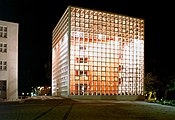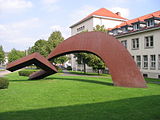Western ring area

|
|
| District: | 310 - Western ring area |
| Residents: | 35,088 (Dec. 31, 2017) |
| Height: | 72 m above sea level NN |
| Post Code: | 38114, 38118, 38122 |
 St. Jakobi Church |
|
The western ring area is a district of Braunschweig and extends from the city center in the east to the districts of Weststadt and Lehndorf in the west and the district of Ölper in the north. Together with the Gartenstadt district in the south, it forms the western ring area .
Information about the city quarter
The western ring area extends from Spinnerstraße in the Eichtal district to the Gartenstadt district. The western ring area was shaped like no other district of Braunschweig by the industrialization that began in the middle of the 19th century.
The residential development was built according to plans by Ludwig Winter at the end of the 19th century as part of the Wilhelminian era belt around the historic city center . It was named after the Braunschweiger Ring , a ring road around what is now the city center .
The plans for the ring area were never fully implemented, some streets were never built, others only partially built on. Part of the southern half was built on in the 1920s and 1930s. An important part of the planning was the ring, a ring-shaped road system around the old town. This was laid out relatively broad, as a promenade for pedestrians was to be created in the middle of the ring. The western ring area has remained almost unchanged since the 1940s; few new homes have been built since then.
- coat of arms
The western ring area has its own city district coat of arms. It is divided vertically and shows in one half a silver, ring-shaped track system on a red background and on the other half a red gear wheel on a silver field.
The tracks symbolize the Braunschweig ring track , while the cog wheel symbolizes the district's industrial past. The colors red and white correspond to the coat of arms of the city of Braunschweig . Arnold Rabbow and Klaus Hoffmann designed the coat of arms, it was adopted on November 12, 2007 at a meeting of the 310 city district council.
history
In 1853 the " Braunschweigische Maschinenbauanstalt " (BMA) was established on Bahnhofstrasse. It initially manufactured railway wagons, but from 1860 onwards specialized in equipping sugar refineries . The Braunschweig sugar refinery with its multi-storey brick building was in the immediate vicinity . In 1858 the Hermann Buchler quinine factory was added on Frankfurter Strasse , which mainly produced quinine and exported it worldwide. In 1865 the August Wilke machine factory was located at Frankfurter Straße 2, which manufactured steam boilers and gasometers .
In 1874 a jute spinning mill was founded in the neighboring Eichtal , which at times employed 2250 people. It was closed in 1982. The Bremer & Brückmann company moved to Juliusstrasse in 1890. At first it manufactured hand sewing machines, but later switched to tin cans with a seam lock and manufactured sheet metal containers. In 1877 the Selwig & Lange company founded a machine factory on Sophienstrasse. Centrifuges, but also machines for the sugar industry , for distilleries and starch factories were manufactured there. In 1885 Gottlieb Luther built a machine factory and mill construction company on Frankfurter Strasse near the Braunschweig state train station. Industrial tracks were later laid right up to the factories. With the construction of the ring track in 1886 by the Braunschweig regional railway , the area received another economic boost, so that 50 more factory buildings and 104 warehouses were built.
The numerous jobs in the quarter created entire residential areas for the employees of these plants. In 1895, Braunschweiger Mühlenbau AG ( MIAG , later Bühler AG ) was added to Ernst-Amme-Strasse , where up to 3,000 people worked at times. In 1907 the Karges-Hammer machine factory also moved to Frankfurter Strasse to manufacture parts for canning factories, steam engines and ice and cooling systems. In addition to these large companies, there were numerous smaller factories in the city quarter, most of which focused on the production and processing of agricultural products. There were canning factories, tin packaging industry, outfitters of canning and sugar factories, foundries, locksmiths and coppersmiths. Particularly characteristic was the large number of small handicrafts and commercial enterprises as well as a large number of retail shops and restaurants in these districts. In the 1970s, many of these plants went bankrupt, with plant closings and mass layoffs. As a result, many apartments became vacant, most of which were newly occupied by guest workers or asylum seekers, so that multicultural residential areas developed, especially in Eichtal and Belford.
Attractions
- The library building of the University of Fine Arts
- The Jakobikirche is a neo-baroque Protestant church from 1911 on Goslarschen Strasse.
- The Josephskirche is a neo-Gothic Catholic brick church from 1903 on Goslarschen Strasse.
- The Braunschweiger ZeitSchiene
- Reformed cemetery
- Sugar refinery on the ARTmax site
- Listed machine factory "Elsner & Holdschmidt" from 1898.
- Engine house outer wall of the Braunschweigische Maschinenbauanstalt
- The entrance portal of the "jute and flax spinning mill" founded in 1874
- Parks
- The Braunschweiger Ringgleis, a green footpath and cycle path, runs parallel to the ring.
- Westpark is located to the west of the western ring area .
- Pictures from the western ring area
Religions
The Evangelical Lutheran Church of St. Jakobi was built in 1909–11 at Goslarschen Strasse 31. Your parish belongs to the Braunschweig provost of the regional church in Braunschweig . Large parts of the south-western ring area belong to the parishes of the St. Michaelis and St. Martini churches in the old town . The community of St. Martini maintains a day-care center next to the old Martini cemetery on Kreuzstrasse. St. Michaelis, St. Martini and the Church of the Resurrection in the Garden City jointly carry out the diaconal work entitled Church in the Western Ring Area in the district center Hugo-Luther-Straße.
The Catholic Church of St. Joseph was built in 1902/03 by Richard Herzig . The church on Goslarschen Strasse belongs to the parish of St. Aegidien . Next to the church there is a day-care center of the same name, in Pfingststraße 1A the St. Kjeld day-care center . Both day care centers are sponsored by the Caritas Association Braunschweig.
The New Apostolic Church at Goslarschen Strasse 84 was closed; the last divine service took place there on June 2, 2012. Today the only New Apostolic Church in Braunschweig is on Körnerstraße.
The youth center at Kreuzstrasse 110 belongs to the Braunschweig community of the Evangelical Methodist Church . The Braunschweig community of the Church of Jesus Christ of Latter-day Saints has a community building at Triftweg 55, the First Church of Christ has a branch at Rennelbergstrasse 9.
The Braunschweig correctional facility has a church on its premises at Rennelbergstrasse 10; Protestant and Catholic services take place there.
Web links
- Western ring area on braunschweig.de
- Detailed map of the western ring area on braunschweig.de
Individual evidence
- ↑ Population figures by city district on the website of the city of Braunschweig , accessed on July 29, 2018
- ↑ Council resolution on the design of the coat of arms ( memento of the original from September 23, 2015 in the Internet Archive ) Info: The archive link was inserted automatically and has not yet been checked. Please check the original and archive link according to the instructions and then remove this notice. (PDF; 43 kB) on braunschweig.de
- ↑ a b c Western ring area on braunschweig.de
Coordinates: 52 ° 15 ' N , 10 ° 30' E





